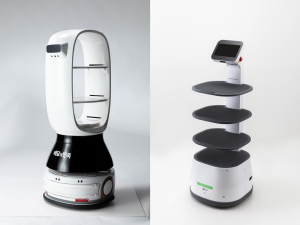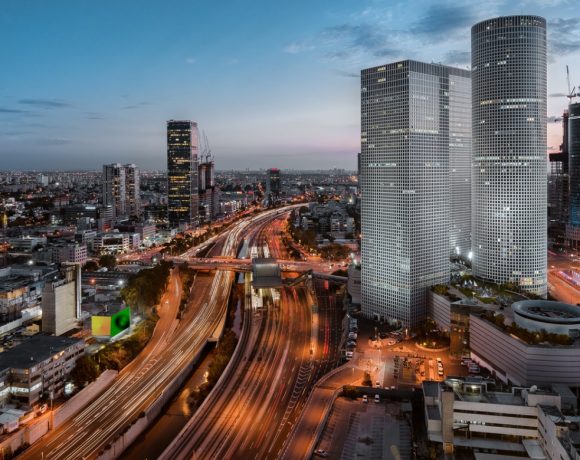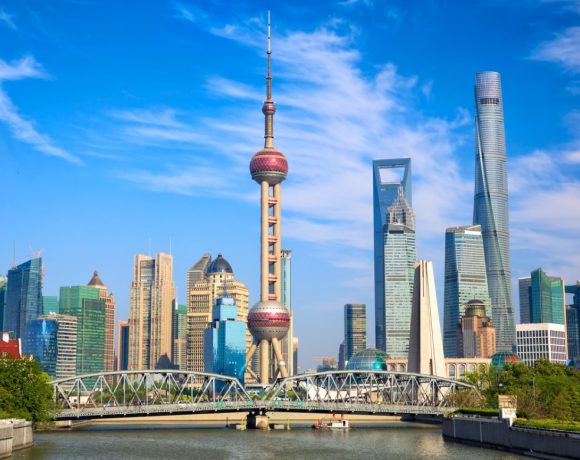- Global Epidemic Prevention Platform digitally collects data for domestic and international tracing and to manage suspected patients. GEPP played a crucial role in the prevention of the second wave of MERS in 2018 and has been showing impressive results in the management of the COVID-19 pandemic.
- Korea’s top two map applications, ‘Naver Map’ and “Kakao Map’ provide real time information on publicly distributed masks by marking pharmacies with different colours based on their available mask stocks.
- The pandemic has also accelerated technological advancements specifically in the ‘contactless’ industry. Increasing number of cafes and restaurants are ‘hiring’ robots to practice social distancing while taking orders and serving customers. Contactless technology also created alternative hiring procedures for tech companies in Korea.
Despite once being the home of the largest outbreak outside China in February 2020, South Korea has succeeded in bringing COVID-19 under control through the use of advanced technology. Combined efforts of the Government and the private sector demonstrated exemplarily how the extremely contagious pandemic could be dealt with through a system of smart data analytics, information sharing and digital technology.
Cooperation between Government and private sector to contain the pandemic
The initiative for pandemic prevention in Korea began in 2016 with the creation of the Global Epidemic Prevention Platform (GEPP), the world’s first tracing platform. GEPP was developed as a response to MERS outbreak in 2015 by Korea Telecom (KT), one of the top three telecommunication companies in Korea. The significance of GEPP was its ability to digitally collect data for domestic and international tracing and to manage suspected patients. The implementation of GEPP in the management of pandemics has been made possible by a modification in the privacy law in Korea. This change, effective since the end of 2017, in case and limited to emergency duration, allows Government to access citizens’ personal information from GPS/mobile cells, credit cards and CCTV. Meanwhile, KT made a proposal to the Korea Centers for Disease Control and Prevention (KCDC) suggesting an expanded participation in GEPP of two other Korean telecommunication companies, SK Telecom and LG U-plus. GEPP played a crucial role in the prevention of the second wave of MERS in 2018 and, nowadays, the nationally expanded platform has been showing impressive results in the management of the COVID-19 pandemic. Following in the footsteps of KT’s innovation, a number of future-oriented measures are being implemented in the Korean society paving the way for an effective and more sophisticated use of technology.
During the first months of 2020, the Korean tracing system had been the focus of attention worldwide. If on the one hand, its efficiency was acknowledged, on the other hand it raised concerns about privacy threats. Currently, European law is strictly preventing the use of personal information, and pandemic outbreaks do not seem to represent an exception. Public opinion supports the importance of the citizens’ privacy protection especially to prevent any kind of discrimination. For these reasons, the adoption of a similar system from European countries has been immediately excluded. However, what really IS the GEPP system versus what IS KNOWN about it?
Domestically, GEPP focuses on mobility and contact by using GPS and mobile cell localisation. This means that the pathways of confirmed cases are identified using the nearest mobile base station by contact time and suspects, who stayed near the confirmed cases. Latest information including the routes of newly confirmed patients, the transportation and medical facilities used by those patients are shared by every district office through official channels such as websites, text messages and blogs. Thus, people who have been in contact with confirmed patients are alerted to be tested and be in self-quarantine while awaiting the test results. This is what IS KNOWN about GEP, which is prevented by the European law.
However, GEPP actually includes other modules for international tracing, outbreak monitoring and assessment too, which match international requirements. Indeed, similar technologies have been already developed locally and implemented by other countries. For instance, to contain infectious diseases, GEPP also utilises roaming data from mobile carriers. People visiting pandemic-prone countries automatically receive text messages upon their departure and arrival. Departing travelers receive messages with guidelines on diseases and regional emergency numbers. Likewise, upon their return to Korea, travelers receive messages advising caution over health conditions during the mean latency period of relevant diseases. The Korea Centers for Disease Control & Prevention (KCDC) also receives real time information on the number of Koreans who have visited high-risk countries.
One of the next goals, which might also open opportunities for international cooperation, is to develop a mobile app-based infection risk analysis using AI. By comparing the data from the confirmed patient’s movement with a person’s past movements, and combining them with self-check of symptoms via an IoT thermometer, it aims to predict the probability of infection at individual level. So far, symptoms monitoring and self-diagnosed health records are mandatory for people in quarantine through a mobile application developed by the Ministry of Interior and Safety.
Smart Mobile Applications in the Light
However, if the three telecommunication companies have been the main players in the cooperation with the Government to contain COVID-19 pandemic, using the data provided by the Government, other companies introduced additional services to help people during the pandemic and simultaneously raise public awareness. For instance, ‘Corona Now’ provides visualised data on the number of confirmed and recovered cases, deaths and the latest press releases while showing nearest medical facilities with testing stations. Another application, ‘Cobaek’ (Corona 100), follows the surge of confirmed cases and sends an alarm to its users when they come within 100 meters of a location visited by newly confirmed patients.
Meanwhile, Korea’s top two map applications, ‘Naver Map’ and “Kakao Map’ provide real time information on publicly distributed masks by marking pharmacies with different colours based on their available mask stocks. Pharmacies are coloured in green if they have more than 100 masks in stock, yellow if they have between 30 and 99, red if below 30 and grey if they have none available.
Social Responses in Daily Life
COVID-19 outbreak impelled a quick action by Government and IT developers, and people’s positive attitude toward the use of technology has been playing a fundamental role in the containment. The pandemic contributed to the research of innovative solutions enhancing a ‘new normality’. In a country like Korea, where technology penetration reaches 95%, notable practices have been going far beyond the screens of smartphones. For instance, the pandemic has accelerated technological advancements specifically in the ‘contactless’ industry. Increasing number of cafes and restaurants are ‘hiring’ robots to practice social distancing while taking orders and serving customers. One robot system introduced in cafes in Daejeon can make up to sixty different types of drinks and provide specific instructions to stir or be careful with hot drinks. An order of six drinks takes less than seven minutes. There is also a serving robot in the cafes, which has self-driving technology implemented to serve the drinks to their customers using the best routes in the cafes. With these technologies, only one human resource is needed for cleaning and refilling the ingredients. Korea’s leading food-tech firm, Woowa Brothers, has been working on building autonomous driving robot for delivery services. After the COVID-19 outbreak, following the growth of public’s interest in contactless purchase, Woowa Brothers introduced the Dilly Tower, a robot that can deliver food from restaurants to customers’ offices by using an interlinked order kiosk, automatic doors and elevator systems. The Woowa Brothers signed an MoU with LG Electronics in February 2020 to commercialise the delivery robot. Similarly, robots are also equipped in a chicken restaurant in Seoul. Upon receiving orders, one robot automatically batters chickens with flour dough and hands it over to the second robot. The other robot then fries the chickens and serves it to the customers. This restaurant rapidly became popular for its hygienic conditions and unchanging flavor achieved through an automated recipe without human intervention.

Dilly Tower
Contactless technology also created alternative hiring procedures for tech companies in Korea. In June 2020, Samsung conducted its employment exam (Global Samsung Aptitude Test) and interviews online. Applicants received ‘test-kits’ that included a question set and a phone holder while the exam was held through the Samsung Monitoring System. Every applicant was required to show themselves, the computer screen and their smartphones on cameras, with the entirety of the exam being supervised by Samsung employees. Samsung had announced in advance that they had tested every possible way of deception as their employees were asked to find ways around the system by cheating the best they could. Thus, acts such as the use of wireless headphones, help from a third person outside the camera range and a cheat sheet behind the computer screen were all pre-discussed and prevented in the actual exam.
Despite the unprecedented threat of the pandemic to global health and economy, Korea has been finding ways to fight COVID-19 with its digitalised society and rapid implementation of innovative measures. Transparent sharing of data by the Government and the private sector’s active participation have flattened Korea’s local epidemic curve and pushed its technology advancements a step further, leading to an optimistic view inside the industry that such future-oriented trends may continue even after the end of COVID-19. However, this acceleration also opens new scenarios about the future of work and the needs driven by the ‘new normality’. How should one assure this transition to be sustainable, instead of representing a threat?






NO COMMENT